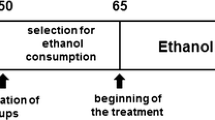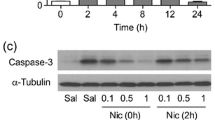Abstract
Cerebellar Purkinje cell and granule cell development are coordinated by Bergmann glia, and are particularly sensitive to ethanol (EtOH) exposure. The liver X receptor (LXR) plays important roles in Bergmann glial development. However, the effect of LXR activation on EtOH-mediated impairment of Bergmann glia and subsequently on Purkinje cell dendritogenesis remains undetermined. Therefore, using immunohistochemistry, quantitative real-time PCR and Western blot, we tested the possible protection of LXR agonist T0901317 (T0) on Bergmann glia and Purkinje cell dendritogenesis in mice exposed to ethanol. Results showed that a brief exposure of EtOH on postnatal day (PD 5) significantly decreased the average body weight of mice at PD 6 without alteration in the brain weight. In EtOH-exposed mice, the number of migrating granule cells in the molecular layer was significantly decreased, and this effect was attenuated by pretreatment of T0. EtOH exposure also resulted in the significant reduction of calbindin-labeled Purkinje cells, their maximum dendrite length, and impairment of Purkinje cell dendritogenesis. Furthermore, EtOH induced the activation of microglia in the Purkinje cell layer and impaired the development of Bergmann glia. However, pretreatment of T0 effectively blocked all of these responses. These responses were found to be mediated by the inhibition of upregulated levels of β-catenin and transcription factor LEF1 in the cerebellum. Overall, the results suggest that activating LXRs on postnatal mice exposed to EtOH is protective to Bergmann glia, and thus may play a critical role in preventing EtOH-induced defects during cerebellar development.








Similar content being viewed by others
References
González-Burgos I, Alejandre-Gómez M (2005) Cerebellar granule cell and Bergmann glial cell maturation in the rat is disrupted by pre-and post-natal exposure to moderate levels of ethanol. Int J Dev Neurosci 23(4):383–388
Charness ME (1993) Brain lesions in alcoholics. Alcohol Clin Exp Res 17(1):2–11
Maier SE, West JR (2001) Regional differences in cell loss associated with binge-like alcohol exposure during the first two trimesters equivalent in the rat. Alcohol (Fayetteville, NY) 23(1):49
Sakata-Haga H, Sawada K, Hisano S, Fukui Y (2001) Abnormalities of cerebellar foliation in rats prenatally exposed to ethanol. Acta Neuropathol 102(1):36–40
Nowoslawski L, Klocke BJ, Roth KA (2005) Molecular regulation of acute ethanol-induced neuron apoptosis. J Neuropathol Exp Neurol 64(6):490–497
Olney JW, Young C, Wozniak DF, Jevtovic-Todorovic V, Ikonomidou C (2004) Do pediatric drugs cause developing neurons to commit suicide? Trends Pharmacol Sci 25(3):135–139
Goodlett CR, Eilers AT (1997) Alcohol-induced Purkinje cell loss with a single binge exposure in neonatal rats: a stereological study of temporal windows of vulnerability. Alcohol Clin Exp Res 21(4):738–744
Hamre KM, West JR (1993) The effects of the timing of ethanol exposure during the brain growth spurt on the number of cerebellar Purkinje and granule cell nuclear profiles. Alcohol Clin Exp Res 17(3):610–622
Hatten ME (1999) Central nervous system neuronal migration. Annu Rev Neurosci 22(1):511–539
Xu HW, Yang Y, Tang XT, Zhao MN, Liang FC, Xu P, Hou BK, Xing Y, Bao XH, Fan XT (2013) Bergmann glia function in granule cell migration during cerebellum development. Mol Neurobiol 47(3):833–844
Rakic P (1971) Neuron–glia relationship during granule cell migration in developing cerebellar cortex. A Golgi and electonmicroscopic study in Macacus rhesus. J Comp Neurol 141(3):283–312
Rakic P, Sidman RL (1973) Organization of cerebellar cortex secondary to deficit of granule cells in weaver mutant mice. J Comp Neurol 152(2):133–161
Lippman JJ, Lordkipanidze T, Buell ME, Yoon SO, Dunaevsky A (2008) Morphogenesis and regulation of Bergmann glial processes during Purkinje cell dendritic spine ensheathment and synaptogenesis. Glia 56(13):1463–1477
Lordkipanidze T, Dunaevsky A (2005) Purkinje cell dendrites grow in alignment with Bergmann glia. Glia 51(3):229–234
Ge WP, Yang XJ, Zhang Z, Wang HK, Shen W, Deng QD, Duan S (2006) Long-term potentiation of neuron–glia synapses mediated by Ca2+−permeable AMPA receptors. Sci Signal 312(5779):1533
Takatsuru Y, Takayasu Y, Iino M, Nikkuni O, Ueda Y, Tanaka K, Ozawa S (2006) Roles of glial glutamate transporters in shaping EPSCs at the climbing fiber-Purkinje cell synapses. Neurosci Res 54(2):140
Takayasu Y, Iino M, Shimamoto K, Tanaka K, Ozawa S (2006) Glial glutamate transporters maintain one-to-one relationship at the climbing fiber–Purkinje cell synapse by preventing glutamate spillover. J Neurosci 26(24):6563–6572
Cui W, Allen ND, Skynner M, Gusterson B, Clark AJ (2001) Inducible ablation of astrocytes shows that these cells are required for neuronal survival in the adult brain. Glia 34(4):272–282
Pérez-Torrero E, Durán P, Granados L, Gutiérrez-Ospina G, Cintra L, Dı́az-Cintra S (1997) Effects of acute prenatal ethanol exposure on Bergmann glia cells early postnatal development. Brain Res 746(1):305–308
Yamada K, Watanabe M (2002) Cytodifferentiation of Bergmann glia and its relationship with Purkinje cells. Anat Sci Int 77(2):94–108
Archer A, Lauter G, Hauptmann G, Mode A, Gustafsson JÅ (2008) Transcriptional activity and developmental expression of liver X receptor (lxr) in zebrafish. Dev Dyn 237(4):1090–1098
Teboul M, Enmark E, Li Q, Wikström A, Pelto-Huikko M, Gustafsson J (1995) OR-1, a member of the nuclear receptor superfamily that interacts with the 9-cis-retinoic acid receptor. Proc Natl Acad Sci 92(6):2096–2100
Fan X, Kim HJ, Bouton D, Warner M, Gustafsson JA (2008) Expression of liver X receptor beta is essential for formation of superficial cortical layers and migration of later-born neurons. Proc Natl Acad Sci U S A 105(36):13445–13450
Xing Y, Fan XT, Ying DJ (2010) Liver X receptor agonist treatment promotes the migration of granule neurons during cerebellar development. J Neurochem 115(6):1486–1494
Pöschl JGD, Dorostkar MM, Kretzschmar HA, Schüller U (2013) Constitutive activation of β-catenin in neural progenitors results in disrupted proliferation and migration of neurons within the central nervous system. Dev Biol 374(2):319–332
Uno S, Endo K, Jeong Y, Kawana K, Miyachi H, Hashimoto Y, Makishima M (2009) Suppression of β-catenin signaling by liver X receptor ligands. Biochem Pharmacol 77(2):186–195
Dikranian K, Qin Y-Q, Labruyere J, Nemmers B, Olney JW (2005) Ethanol-induced neuroapoptosis in the developing rodent cerebellum and related brain stem structures. Dev Brain Res 155(1):1–13
Taranukhin AG, Taranukhina EY, Saransaari P, Podkletnova IM, Pelto-Huikko M, Oja SS (2010) Neuroprotection by taurine in ethanol-induced apoptosis in the developing cerebellum. J Biomed Sci 17(Suppl 1):S12
Li ZF, Gao CY, Huang HQ, Sun WZ, Yi HL, Fan XT, Xu HW (2010) Neurotransmitter phenotype differentiation and synapse formation of neural precursors engrafting in amyloid-beta(1-40) injured rat hippocampus. J Alz Dis 21(4):1233–1247
Livak KJ, Schmittgen TD (2001) Analysis of relative gene expression data using real-time quantitative PCR and the 2−ΔΔCT method. Methods 25(4):402–408
Eiraku M, Tohgo A, Ono K, Kaneko M, Fujishima K, Hirano T, Kengaku M (2005) DNER acts as a neuron-specific Notch ligand during Bergmann glial development. Nat Neurosci 8(7):873–880
Yamada K, Fukaya M, Shibata T, Kurihara H, Tanaka K, Inoue Y, Watanabe M (2000) Dynamic transformation of Bergmann glial fibers proceeds in correlation with dendritic outgrowth and synapse formation of cerebellar Purkinje cells. J Comp Neurol 418(1):106–120
Weyer A, Schilling K (2003) Developmental and cell type-specific expression of the neuronal marker NeuN in the murine cerebellum. J Neurosci Res 73(3):400–409
Willert K, Nusse R (1998) β-catenin: a key mediator of Wnt signaling. Curr Opin Genet Dev 8(1):95–102
Riikonen J, Jaatinen P, Rintala J, Pörsti I, Karjala K, Hervonen A (2002) Intermittent ethanol exposure increases the number of cerebellar microglia. Alcohol and Alcohol 37(5):421–426
Grosche J, Matyash V, Möller T, Verkhratsky A, Reichenbach A, Kettenmann H (1999) Microdomains for neuron–glia interaction: parallel fiber signaling to Bergmann glial cells. Nat Neurosci 2(2):139–143
Iino M, Goto K, Kakegawa W, Okado H, Sudo M, Ishiuchi S, Miwa A, Takayasu Y, Saito I, Tsuzuki K (2001) Glia-synapse interaction through Ca2+−permeable AMPA receptors in Bergmann glia. Sci Signal 292(5518):926
Selvadurai HJ, Mason JO (2011) Wnt/β-catenin signalling is active in a highly dynamic pattern during development of the mouse cerebellum. PLoS One 6(8):e23012
Wang X, Imura T, Sofroniew MV, Fushiki S (2011) Loss of adenomatous polyposis coli in Bergmann glia disrupts their unique architecture and leads to cell nonautonomous neurodegeneration of cerebellar Purkinje neurons. Glia 59(6):857–868
Makoukji J, Meffre D, Grenier J, Liere P, Lobaccaro J-MA, Schumacher M, Massaad C (2011) Interplay between LXR and Wnt/β-catenin signaling in the negative regulation of peripheral myelin genes by oxysterols. J Neurosci 31(26):9620–9629
Chuu C-P (2011) Modulation of liver X receptor signaling as a prevention and therapy for colon cancer. Med Hypotheses 76(5):697–699
Shackleford GG, Makoukji J, Grenier J, Liere P, Meffre D, Massaad C (2013) Differential regulation of Wnt/beta-catenin signaling by liver X receptors in Schwann cells and oligodendrocytes. Biochem Pharmacol 86(1):106–114
Tiwari V, Chopra K (2013) Resveratrol abrogates alcohol-induced cognitive deficits by attenuating oxidative-nitrosative stress and inflammatory cascade in the adult rat brain. Neurochem Int 62(6):861–869
Crews F, Nixon K, Kim D, Joseph J, Shukitt–Hale B, Qin L, Zou J (2006) BHT blocks NF-κB activation and ethanol-induced brain damage. Alcohol Clin Exp Res 30(11):1938–1949
Shirpoor A, Salami S, Khadem-Ansari MH, Minassian S, Yegiazarian M (2009) Protective effect of vitamin E against ethanol-induced hyperhomocysteinemia, DNA damage, and atrophy in the developing male rat brain. Alcohol Clin Exp Res 33(7):1181–1186
Tiwari V, Chopra K (2012) Attenuation of oxidative stress, neuroinflammation, and apoptosis by curcumin prevents cognitive deficits in rats postnatally exposed to ethanol. Psychopharmacology 224(4):519–535
Xu P, Li D, Tang X, Bao X, Huang J, Tang Y, Yang Y, Xu H, Fan X (2013) LXR agonists: new potential therapeutic drug for neurodegenerative diseases. Mol Neurobiol. doi:10.1007/s12035-013-8461-3
Zhang-Gandhi CX, Drew PD (2007) Liver X receptor and retinoid X receptor agonists inhibit inflammatory responses of microglia and astrocytes. J Neuroimmunol 183(1):50–59
Marı́n-Teva JL, Dusart I, Colin C, Gervais A, van Rooijen N, Mallat M (2004) Microglia promote the death of developing Purkinje cells. Neuron 41(4):535–547
Acknowledgments
This study was supported by the National Nature Science Foundation of China (no. 31070927 and no. 31071299) and the Foundation of the Third Military Medical University (no. 2011XQN05).
Author information
Authors and Affiliations
Corresponding authors
Rights and permissions
About this article
Cite this article
Yang, Y., Tang, Y., Xing, Y. et al. Activation of Liver X Receptor Is Protective Against Ethanol-Induced Developmental Impairment of Bergmann Glia and Purkinje Neurons in the Mouse Cerebellum. Mol Neurobiol 49, 176–186 (2014). https://doi.org/10.1007/s12035-013-8510-y
Received:
Accepted:
Published:
Issue Date:
DOI: https://doi.org/10.1007/s12035-013-8510-y




